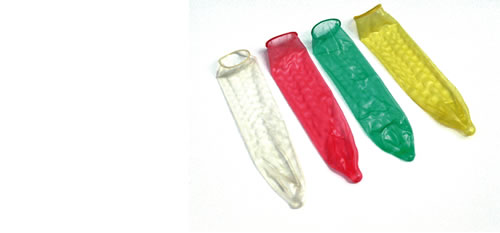Condoms have been around for centuries and have been made from materials including paper, animal skins and rubber. Today's latex and polyurethane condoms lower the risk of transmitting sexually transmitted infections (STIs) or becoming pregnant. When used correctly and consistently, condoms continue to be the best protection against HIV and STIs. Read on to find out more about them.

Safer Sex
Condoms
What are condoms?
A condom is a sheath-like covering, usually made of a thin but strong latex rubber that fits over an erect penis. You have many choices when it comes to condoms. Some are lubricated with plain lube, flavored lube or spermicide, and they're also available without any lubricant. The options continue with a variety of specialty condoms: different shapes, colors, sizes and flavors. Just be sure the condom you choose says it prevents STIs and pregnancy.
Condoms made of latex are the most effective at STI prevention and are the most widely available type. Polyurethane condoms are also available and do provide good STI and pregnancy protection. Some condoms are made of animal skin, often called lambskin condoms. These "natural condoms" are effective for pregnancy prevention only. They do not provide protection against STIs because the pores in the animal skin are large enough to allow some bacteria or viruses to pass through the condom. Please note that when we discuss condoms effectiveness for STI prevention below, we are referring to latex or polyurethane condoms only.

How do condoms work to prevent STIs and pregnancy?
Latex or polyurethane condoms help reduce the risk of STIs by preventing the exchange of fluids including semen, vaginal secretions, and blood during vaginal, anal or oral sex. They also provide some protection against STIs which are transmitted via skin to skin contact, as long as the affected area is covered by the condom. A condom helps prevent pregnancy by preventing semen from entering the vagina.
How effective are condoms in preventing pregnancy and STIs?
When condoms are used perfectly for vaginal intercourse--this means used correctly each and every time a couple has sex--the chance of becoming pregnant is less than 3%. But, not everyone who uses condoms uses them every time and not everyone uses them correctly, so the average risk of becoming pregnant is 12%.
If you are concerned about the strength of your condom, a Consumer Reports study found that actual condom breakage is rare: 1 in 165 during vaginal sex and 1 in 105 during anal sex. When you take human error into account, failure rates would be higher. Using a condom correctly will decrease the chance of breakage.
Condoms are currently the best method of STI protection. When used correctly and consistently, condoms will greatly reduce your exposure to STIs.
How do I use a condom?
Both you and your partner should know how to use a condom. If you have a penis, you can practice the steps to putting on a condom when you are alone. Masturbating while wearing a condom is a good way to get used to the feel and fit as well. If you don't have a penis, you can practice the steps below on a banana, zucchini or other similarly shaped object. This preparation will make the process smoother and easier when you use a condom with a partner.
The first thing to know is that you put the condom on when the penis is erect, before there is any contact between the penis and another person's body. Fluid released from the penis during the early stages of an erection can transmit STIs and may contain sperm.
-
Open carefully
-
Check the expiration date. To ensure the package has not been punctured, pinch the package to feel for the air bubble. Do not open the condom wrapper with scissors or your teeth. If the condom is brittle or sticky, throw it out and get a new one.
-
-
Apply lubricant
-
Lubricant will reduce the risk of your condom breaking during use. You can apply a tiny amount of lube to the inside tip of the condom and to the outside of it once you roll it down. Be careful when applying lube to the inside of the condom. Too much lube could cause the condom to slip off. NEVER use oil-based lubricants like hand cream, Vaseline, massage oil, or butter. These weaken latex condoms quickly, making them much more likely to leak or break. ONLY use water-based or silicone lubricants like Astroglide, Pjur, Wet or Liquid Silk.
-
-
Pinch, place, & roll down
-
Pinch air from the tip of the condom with your thumb and forefinger. This will reduce the chance of the condom breaking by leaving space at the tip of the condom to hold the ejaculate and preventing an air bubble from being trapped at the tip. Place the rolled up condom against the end of the hard penis. Unroll the condom down to the base of your penis with your other hand. If the condom was placed on the penis, but couldn't roll down because it was inverted, make sure a new condom is used. If you flip the condom over, there is a chance that fluids from the tip of the penis are now on the outside of the condom.
-
-
Withdraw
-
Immediately after ejaculation and while the penis is still erect, hold the rim of the condom securely at the base of the penis and pull out. This will keep the condom from slipping off inside your partner and keep any semen from being spilled.
-
-
Don't Flush
-
Remove the condom from the penis, away from your partner's body. Wrap the condom in tissue and throw it away. Do not flush condoms down the toilet. They're not biodegradable and could block up your plumbing.
-
A new condom should be used each and every time you have vaginal, oral or anal sex. Never reuse a condom. For increased protection against breakage and against transmission of infection, use a new condom or dental dam when you switch between types of sexual activity (for example, from anal sex to vaginal sex).
What should I do if the condom breaks?
If the condom breaks, tears or slips off during sex, there may be a chance that either partner has been exposed to an STI. You and your partner can make appointments to be tested at Health Services by calling 401.863-3953, or you can click here for more information on additional testing sites in Providence.
If you are concerned about pregnancy, you may want to consider using Emergency Contraception (EC). EC is available without a prescription and with no out of pocket cost for any Brown student at the Health Services pharmacy and should be taken within 72 hours (3 days) after unprotected vaginal intercourse, the sooner the better. You can call Health Services at 401.863-1330 to talk to a nurse about whether to take EC.
If you are concerned about exposure to HIV (particularly if you know your partner is HIV+ or if the condom broke during anal sex and your partner's HIV status is unknown), you may want to consider using Post Exposure Prophylaxis (PEP). PEP is available by prescription at Health Services.
What if I have an allergy to latex condoms?
People who have an allergy to latex can use a condom made of polyurethane plastic instead. A polyurethane condom has a looser fit, a longer shelf life and reportedly transmits more body heat through the condom.
Internal condoms (also called Reality or female condoms) are another option for people with latex allergy because they too are made of polyurethane rather than latex. You can visit our page on internal condoms for more information.
How much do condoms cost and where can I get them?
We have condoms available for Brown students here in Health Services. Supplies are available in the 1st or 3rd floor bathrooms or in Health Promotion on the 3rd floor. The identity centers on campus, SHAG peer educators and RPLs in the residence halls also have safer sex supplies. All locations offer external condoms and dental dams. In Health Promotion we also offer internal condoms, non-latex condoms, XL size condoms, gloves, and lubricant. Brown students can also order safer sex supplies online for delivery to their campus mailbox through Ship n SHAG.
All of our safer sex supplies are available without charge. We just ask that you take only what you need and that you not use the free supplies if you need large quantities. If you need larger amounts of condoms, you can purchase 50 condoms for $5 or 100 condoms for $10 from the Health Services Pharmacy.
Related Links
Durex
This entertaining site has information available on the different styles of condoms available, quizzes on how to decide which condom is best for you, and the "Durex Clinic" where commonly asked condom questions are answered.






